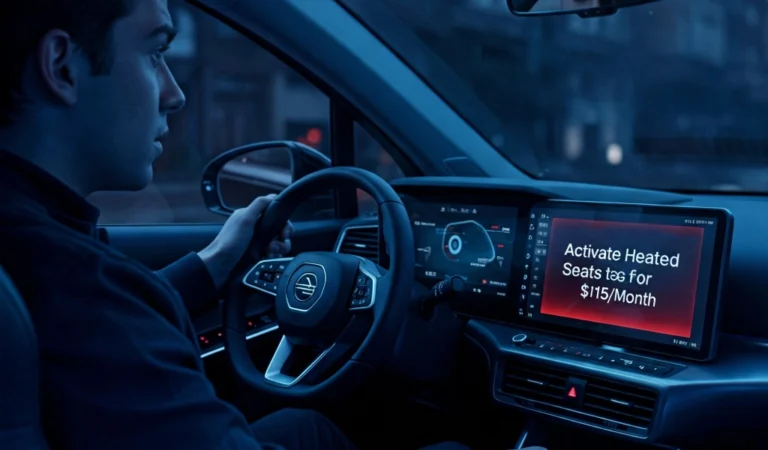In 2025, you’re no longer just buying a car—you’re subscribing to it.
That’s right. You pay tens of thousands for a new vehicle, and then automakers ask you to pay monthly for heated seats, faster acceleration, or even remote start. The trend of subscription-based car features is here, and drivers across the U.S. are not happy.
From BMW to Mercedes and even Toyota, car manufacturers are locking basic car features behind a paywall. In this article, we’ll break down:
- Why car companies are doing this
- What it means for everyday drivers
- How you can avoid being overcharged
- Which automakers are pushing back
What Are Subscription-Based Car Features?
Subscription-based car features are built-in hardware or software functions that require an ongoing fee to activate.
Instead of choosing a trim with heated seats or lane assist, you get the hardware but pay monthly to use it. Think of it like Netflix, but for your car.
Common Examples in 2025:
| Feature | Monthly Fee | Brands Involved |
|---|---|---|
| Heated Seats | $10–$18/month | BMW, Toyota |
| Remote Start | $8–$12/month | Toyota |
| Faster EV Acceleration | $30–$60/month | Mercedes |
| Adaptive Cruise Control | $15–$25/month | Tesla, BMW |
| Navigation Upgrades | $10–$20/month | GM, Ford |
Why Automakers Are Doing This
Auto companies are under pressure to diversify revenue. With electric vehicles (EVs) requiring less maintenance and competition growing, brands are copying the SaaS (Software as a Service) model.
Benefits for Automakers:
- ✅ Predictable Monthly Revenue
- ✅ Increased Lifetime Value per Vehicle
- ✅ Easy Over-the-Air (OTA) Feature Delivery
- ✅ Upsell Opportunities After Purchase
In their eyes, it’s just like how Apple sells iCloud or how Tesla updates its cars post-purchase.
Why Consumers Are Pushing Back
Drivers in 2025 feel cheated — and for good reason. Imagine paying for hardware that’s already in your car, but needing to subscribe just to use it.
Common Complaints:
- “I already paid for the car, why charge me again?”
- “It’s greedy and disrespectful to loyal buyers.”
- “What happens when I sell the car? Do features disappear?”
In forums like Reddit and X (formerly Twitter), car owners are calling this trend “daylight robbery.”
Heated Seats: The Breaking Point
Heated seats are one of the oldest comfort features in modern vehicles. But in 2025, they’ve become a symbol of the subscription car backlash.
What’s Happening?
- The hardware is installed by default
- But to activate it, drivers must pay monthly
- Cancel your plan? The heaters stop working — even though they still can
This has left many asking: Do we even own our cars anymore?
How This Affects Resale and Used Cars
Subscription features also impact the resale value of vehicles.
Here’s how:
- Some features don’t transfer to new owners
- Used car buyers may need to re-subscribe
- Buyers might prefer cars without “locked” features
This could lead to a “software divide” in the used car market, where two identical cars have different values — simply because one has features unlocked.
How to Avoid Overpaying for Car Features in 2025
Before buying a car this year, ask the dealer or check the manufacturer website for subscription details.
Buyer Checklist:
✅ Are heated seats included permanently?
✅ Are remote features tied to a subscription?
✅ Will these features transfer to the next owner?
✅ Can you prepay to unlock features for life?
Pro Tip: Ask for a printed list of all subscription-based features before signing your lease or finance contract.
Which Automakers Are Offering These Subscriptions?
Here’s a quick summary of what leading brands are doing in 2025:
| Automaker | Subscriptions in Place | Customer Feedback |
|---|---|---|
| BMW | Heated seats, camera unlocks | Negative backlash in EU & US |
| Mercedes-Benz | Faster acceleration | Mixed reviews |
| Toyota | Remote start | Criticized by tech press |
| Tesla | Self-driving & connectivity | Long-time SaaS model |
| Hyundai/Kia | No subscriptions | Positive feedback |
| Ford | Optional bundles | Customer choice respected |
Legal and Ethical Debates Around Subscription Cars
This isn’t just about tech—it’s turning into a consumer rights issue.
In late 2024 and early 2025, lawmakers in California, New York, and Illinois started debating:
- Should car features be considered hardware or service?
- Should carmakers be required to disclose all subscriptions upfront?
- Should subscription-based features expire after a few years?
There’s even talk of regulating OTA updates in future consumer protection laws.
Alternatives to Subscription Models
Some automakers are offering buy-once options for features — and consumers love it.
Look for:
- Lifetime feature unlocks (one-time payments)
- Bundled packages that include essentials
- Non-subscription brands (Hyundai, Subaru, Mazda)
You may pay slightly more upfront, but you avoid recurring fees and future surprises.
The Future of Cars: Platform or Product?
In 2025, we’re seeing the car shift from a one-time purchase to a digital platform. While this offers flexibility, it also creates tension over ownership vs. access.
Will we eventually have to pay for:
- Unlocking top speed?
- Accessing Bluetooth or Wi-Fi?
- Using power windows?
It’s possible. That’s why consumers must stay informed and demand transparency.
Final Thoughts: Know Before You Drive
Subscription-based car features like heated seats for $15/month reflect a bigger transformation in the auto industry. While carmakers see dollar signs, consumers see restrictions, confusion, and frustration.
If you’re buying a car in 2025, don’t just check the horsepower — check the monthly charges hiding in the dashboard.
Ownership should mean ownership — not renting comfort.



1 Comment
Pingback: Subscription Tech: The Greatest Scam of the 21st Century?